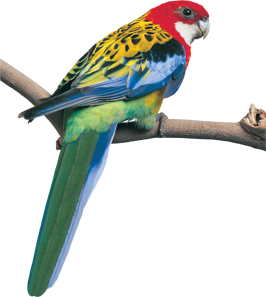Profiles
EASTERN ROSELLA
(Platycercuseximius)
Family: Parrot
Origin: Found in highly timbered country in humid and semi-humid areas, from the seaboard to fringes of inland plains.
Size: 300mm including tail of 155mm
Description:
The male bird has a red head, white cheeks, and the feathers of the nape, back and wings are black with an edging of bright yellow-green. The rump and upper tail coverts are pale green or blue-green. The central tail feathers are green-blue, the outer tail feathers are blue and edged with white. The vent and under tail coverts are red. The under wing coverts, shoulders and flight feathers are blue.
The eyes are brown, the beak is pale grey and the legs are grey.
The female is similar looking to the male except that it has duller head and breast colours. The immature chicks also have a duller head colour and their napes and the back of their crown is green.
Care:
In the wild these birds nest in hollow limbs or trees high off the ground, but they have been known to nest in logs on the ground or even fence posts.
Even if only keeping one bird you do need to provide it with a large cage, and aviaries need to be as large as possible with one end completely enclosed. It needs to be damp proof and draught free as birds can easily succumb to chills.
Cages and aviaries need to be made of heavy gauge wire or the birds will soon chew through it, and for this reason wooden cages should not be used – wooden cages are also less hygienic.
Hollow logs should be supplied for nesting along with a wide shallow water dish for bathing as these birds loves to take “a dip”.
Eats:
Good quality small parrot mix, fresh greens, apples, oranges, capsicum, cos lettuce, endive, mung beans, carrots, celery and needs to be supplied with plenty of cuttlefish bone and grit to help it digest its seed.
In the wild this bird can be quite destructive to orchards when in large numbers. They will also eat insects and their larvae, wild seeds, blossoms and nectar.
Features:
The breeding is from August to January and the hen will usually lay four eggs that are incubated for 20 days. Once hatched, the chicks will stay in the nest for about 30 days, but they will then stay with the parents for many months forming close-knit groups. They then get their adult plumage after 12 months
Call:
They let out a loud ascending call or a metallic piping note often repeated twice. If alarmed in any way they immediately let out a loud screech to warn other birds in their flock. Subdued ongoing chatter is maintained while happily eating.
Personality:
These birds can be tamed and become very affectionate to their owners.
